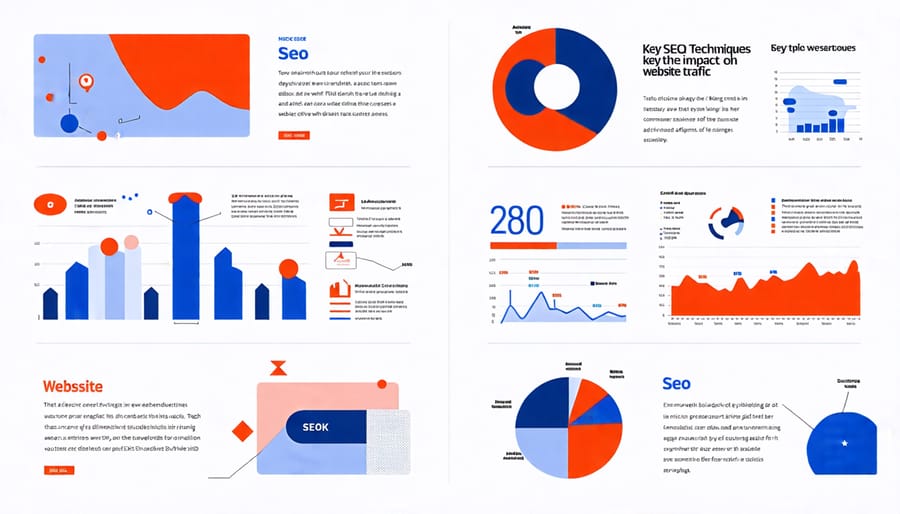Harness the power of social media by posting engaging content consistently. Tailor your posts to your audience’s interests and utilize analytics to refine your strategy. Leverage email marketing to build relationships and convert leads; ensure your messages are personalized and provide value, improving open rates and engagement. Optimize your website for search engines by incorporating relevant keywords, enhancing load speed, and crafting compelling meta descriptions to boost visibility and reach. Don’t overlook the impact of community engagement—participate in local events or collaborate with fellow entrepreneurs for greater networking and market penetration. Explore more local marketing tips to enhance your business presence.
Understanding Your Audience
Identifying Customer Personas
Creating detailed customer personas is a critical step in shaping effective marketing strategies for small online businesses. By understanding who your customers are, what they need, and how they behave, you can tailor your marketing efforts to meet their expectations more precisely. Customer personas help identify the right messaging, channels, and products to focus on, leading to more meaningful interactions and improved customer satisfaction. Take inspiration from successful Canadian small businesses that have developed strong customer personas, enabling them to connect deeply with their audience and drive growth. Through careful persona development, your marketing efforts become more targeted and efficient, maximizing your return on investment.

Engaging with Audience Feedback
Engaging with audience feedback is essential for refining your marketing strategies as a small online business. Start by actively seeking input through surveys, reviews, and social media interactions to understand your customers’ needs and preferences. Implement tools like Google Analytics to gain insights into customer behaviour. Consider setting up periodic feedback sessions or polls to stay updated on audience sentiment. Use this valuable information to adjust your marketing tactics, tailoring your content, promotions, and communications to better meet customer expectations. By valuing and acting on feedback, you’ll not only enhance customer satisfaction but also build stronger relationships that foster loyalty and growth.
Leveraging Social Media
Choosing the Right Platforms
When choosing social media platforms for your small online business, focus on where your target audience is most active. Start by researching each platform’s demographics. For instance, if your customers are young adults, Instagram or TikTok might be effective channels. For business-to-business markets, consider LinkedIn for networking and engagement. Remember, quality trumps quantity; it’s better to excel on a few platforms rather than spread resources thinly across many. Look for real-life success stories from similar businesses to guide your choices. By aligning your platform strategy with your audience’s preferences, you can foster genuine connections and drive meaningful growth.

Creating Engaging Content
Creating engaging content is pivotal for small online businesses aiming to connect with their audience and encourage sharing. To begin, understanding your audience is crucial. Dive into customer feedback and preferences to tailor your content, ensuring that it resonates and meets their interests. Canadian small business owners can benefit by incorporating relatable stories and addressing everyday challenges faced by local entrepreneurs.
Use a blend of captivating visuals, compelling narratives, and concise information to maintain interest. Try different formats like videos, infographics, and blogs to keep your content dynamic and versatile. Incorporating digital marketing tools can streamline creative processes, making content development more efficient and effective.
Storytelling is another powerful tool—share real-life success stories from Canadian entrepreneurs to inspire and engage. Lastly, encourage interaction by prompting questions or discussions, and always provide value to your audience. By implementing these strategies, your content will not only attract but also invite others to share, expanding your reach organically.
Developing an Email Marketing Campaign
Building a Strong Email List
Building a strong email list starts with offering value that resonates with your audience. Encourage visitors to subscribe by providing exclusive content, such as discounts or e-books tailored to their interests. Utilize pop-ups on your website and social media channels to gather subscribers, ensuring you comply with Canadian Anti-Spam Legislation. Once you have a list, regularly update it by removing inactive email addresses and segmenting contacts based on engagement levels. Consider integrating must-have tech tools to automate and personalize your email campaigns. These efforts, combined with genuine engagement, can nurture lasting customer relationships.
Crafting Compelling Email Content
To craft compelling email content that drives action, start by understanding your audience. Know what your recipients value, and tailor your message to address their needs. Use a clear and engaging subject line to grab attention and encourage opening the email. In the body, write concisely, ensuring every word serves a purpose. Start with a strong opening that piques interest, and include a personal touch, like the recipient’s name, to add a sense of connection.
Use straightforward language and break down your content into short paragraphs to enhance readability. Include a clear call-to-action (CTA) that tells recipients exactly what you want them to do, whether it’s visiting your website, signing up for a webinar, or making a purchase.
Real-life success stories can be powerful; share how your product or service has positively impacted other businesses. Finally, make sure your emails are mobile-friendly to reach those on-the-go. By following these steps, you can turn your email campaigns into a key driver for business growth.
Utilizing Search Engine Optimization (SEO)

Keyword Research and Implementation
Begin your keyword research by identifying terms that your Canadian audience is actually using. Tools like Google Keyword Planner can offer insights into popular search phrases. Focus on long-tail keywords specific to your niche, as these often have less competition and attract more targeted traffic. Once you have a list, implement them naturally into your website’s content, including page titles, product descriptions, and blog posts. A local bakery, for example, successfully boosted its online visibility by incorporating regional terms such as “artisanal bread Toronto.” Regularly review and update your keywords to stay in sync with evolving customer interests.
Enhancing Website Usability
Improving your website’s usability is crucial for boosting SEO and gaining customer trust. Start by ensuring your site is mobile-friendly, as more Canadians shop online via smartphones. Simplify navigation with clear menus and search functionalities, enabling users to find what they need quickly. Use descriptive, keyword-rich titles and meta tags to enhance search engine visibility. Incorporate fast loading times by optimizing images and reducing unnecessary plugins. Consider real-life examples, like a small Toronto bakery that revamped its website, resulting in increased traffic and sales. These changes not only improve user experience but also enhance your online presence and drive business growth.
Incorporating Real-Life Success Stories
One standout story comes from Harmony Teas, a small boutique tea company based in British Columbia. Faced with the challenge of reaching a broader audience, Harmony Teas strategically implemented a combination of social media marketing and local SEO. By engaging authentic content on Instagram and Facebook, they were able to increase their following significantly. They also optimized their website with region-specific keywords, which improved their search engine rankings locally. As a result, their online sales soared by 35% within six months, and their brand recognition in local markets strengthened.
Another inspiring example is Evergreen Handmade Soaps from Ontario, which utilized email campaigns to cultivate and maintain customer relationships. By segmenting their email list and personalizing content, Evergreen Handmade Soaps reported a 40% uptick in customer retention. These targeted campaigns included monthly newsletters that featured exclusive promotions and helpful tips on skincare, keeping their audience engaged and informed.
Lastly, consider Maple Grove Studios, a Toronto-based digital design consultancy. They harnessed the power of collaboration by partnering with complementary local businesses to host online workshops and webinars. This approach not only expanded their reach but also built a community around their brand. These real-life successes illustrate that with creativity and strategic application of marketing techniques, small businesses can thrive in today’s competitive online landscape.
Conclusion
In conclusion, the journey to growing your small business online can be both exciting and rewarding. By understanding your audience and utilizing social media effectively, you lay the groundwork for a strong online presence. Implementing well-crafted email campaigns and optimizing your website for search engines can significantly enhance your digital visibility. Real-life success stories remind us that with determination and the right strategies, impactful results are achievable.
We encourage you to apply these strategies consistently, combining creativity with the insights gained from your audience’s feedback and data analytics. Remember, achieving growth doesn’t happen overnight, but with perseverance and adaptability, your small business can thrive in the digital landscape. Embarking on this digital transformation journey may pose challenges, but it also presents opportunities for innovation and differentiation in the marketplace. By taking these steps, you are not just expanding your business online, but also contributing to a vibrant, more connected Canadian business community.
You may also like
-
Why Brazilian Betting Platforms Want to Partner with Your Canadian Business
-
Revamp Your Small Business: Digital Transformation Success in Canada
-
Transform Your Small Business with Must-Have Automation Tools
-
Boost Your Small Business with Google Analytics: A Step-by-Step Approach
-
Boost Team Spirit Fast: 5-Minute Activities for Busy Small Groups

